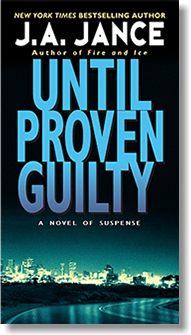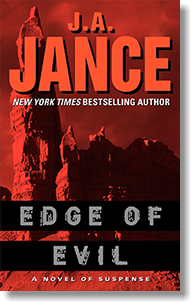
 J.P. BEAUMONT
J.P. BEAUMONT
J.P. Beaumont is a figment of my imagination although, after writing about him for almost twenty years, he feels more like an old friend. When it’s time to start writing a new book about him, it’s like renewing an acquaintance with someone who’s been out of town for a while, and we need to catch up on what’s been happening.
Physically, Beau owes his appearance to a Pima County homicide detective I met during the course of a 1970 case involving a serial killer in Arizona. His affinity to the bottle and his eventual sobriety are, of course, linked to my experiences with my first husband–the drinking that is. JP. Beaumont was smart enough to sober up, once the problem was brought to his attention. My husband, on the other hand, died of chronic alcoholism at age 42.
I come to the task of writing with the understanding that my characters are people first and police officers second. When they get hurt either physically or emotionally, they don’t get over it within the next twenty pages. Things that happen to them in one book impinge on what they’re doing in the next one. That’s why you’ll find the books listed on the Books in Order page. Not that they have to be read that way, but because it may be more fun.
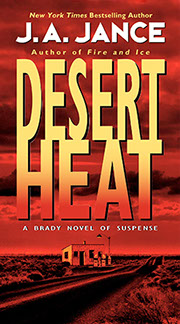 JOANNA BRADY
JOANNA BRADY
After writing my first thriller, when it was time to go back to J.P. Beaumont, I found that writing was fun again. That was when my editor suggested that I might consider starting a second series so I'd be able to alternate between sets of characters.
I had written ten books through a middle aged male detective's point of view. It seemed to me that it would be fun to write about a woman for a change. Because Beau was a Seattle homicide detective, most of the books took place in and around Seattle. Up to that time, I had spent the bulk of my life living in Arizona. And it seemed like it would be fun to use some of the desert stuff that was percolating in the back of my head.
In many of the books I’d read that featured female sleuths, I had found that the characters seemed to live isolated, solitary lives with maybe a cat and a single dying ficus for company. Most of the women I knew lived complicated lives that involved husbands and children, in-laws and friends. They juggled family responsibilities and jobs along with church and community service. I set out to make my character, Joanna Brady (Yes, yes, I know. Another J. B. name) into someone whose life would reflect that complicated act of juggling.
As a writer, I try not to be too buoyed by good reviews or too devastated by bad ones, but there was one review that came in on the Joanna Brady books that is still engraved on my heart. It came from Mostly Murder. “Every woman in America is obviously not a sheriff, but Joanna Brady is every woman.” Thank you, Mostly Murder.
 ALI REYNOLDS
ALI REYNOLDS
What do you do if you’re a forty-something female television newscaster and the powers that be suddenly force you off the air because they’ve decided you’re over the hill? And what if you discover, almost simultaneously, that your media mogul husband is a philandering rat? And what if you also learn that your best friend from high school, a devoted mother suffering from a debilitating illness, has suddenly disappeared?
If you happen to be Alison Reynolds, you go back home, plant your feet firmly on the ground, roll up your sleeves, and go to work. Encouraged by her college-aged son, Ali leaves the old media behind and ventures into the new media where she discovers that working from home as a “pajama-clad blogger” can be a surprisingly dangerous endeavor.
Ali’s return to small town (Sedona) Arizona puts her in the middle of her parents’ travails as long-time owners and operators of a local diner. Her mother’s astute observations keep Edie Larson’s finger firmly on the pulse of everything going on in town while her father’s unfailing kindness to down-and-outers proves to be a bane, an inspiration, and ultimately a blessing.
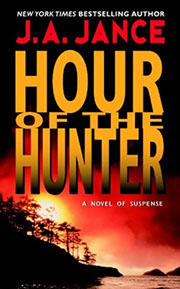 THE WALKER FAMILY
THE WALKER FAMILY
Mysteries are enduringly popular. I’ve read them all my life, from Nancy Drew and the Hardy Boys, right on through John D. MacDonald and Lawrence Block. Mysteries work as stories with the required beginnings, middles and ends. Those ends usually entail the bad guy getting caught and/or punished. That is the rule. If the bad guy doesn’t get it in the end, you may be dealing with literature, and that’s another kettle of fish entirely.
In mysteries, the reader doesn’t know who the killer is until the end. In thrillers, the reader knows who the bad guy is from the beginning. The only question is how much damage he’s going to do before he gets caught.
I think many people who become writers do so because they’re ill-suited to having regular jobs. That’s certainly true in my case. And so, after writing nine Detective Beaumont original paperbacks in a row, by 1989 I was beginning to feel as though I had a regular job. When I threatened to knock off Beau in my next book, my editor was aghast. “Don’t do that,” he said. “Remember that first book of yours, the one that was never published?”
I remembered it well. My first manuscript had been called Hour of the Hunter. It was a slightly fictionalized version of a series of murders that had taken place in Arizona in 1970, and it was one in which my first husband had played a key role as a witness. The manuscript was universally turned down for good reason. For one thing, in its original form it was 1200 pages long. But even after it was trimmed down by 550 pages to a mere 650, it still didn’t make the cut. Editors said that the stuff that was real was “unbelievable” whereas the parts that were fictional were “fine.”
My agent finally suggested that I try my hand at fiction, and that’s where J.P.Beaumont stepped into the picture. Between 1985 and 1989 when I was having this conversation with my editor, I’d had an emotional encounter with some of the still-grieving family members of that series of murders in Arizona. Just meeting them one time was enough to convince me that real murders affect real people. I stopped writing true crime on the spot.
So when my editor suggested that I revisit that original manuscript, I didn’t want to bring up that awful time for that still fractured family. Not only that, the killer was still in prison in Arizona, and I didn’t want to write a book that he could point to and say to his friends in Florence, “Hey guys, this book’s about me."
I ended up selling Morrow and Avon a book called Hour of the Hunter, but the only thing it has in common with that original manuscript is the title. And, twenty years later, of all my books, it remains my favorite.
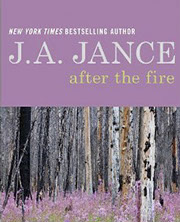 AFTER THE FIRE
AFTER THE FIRE
Poetry reading gigs are hard to come by, but I spent a day recording After the Fire for an audio edition that is being published by BBC America Audio Books. Reading those poems and the accompanying essays aloud was still a surprisingly emotional experience, even though much of the material was written over thirty years ago. What the poetry has to say still resonates with me and, if my e-mail is any indication, with my readers as well. Readers tell me that following my journey of love and loss has made them feel less alone in their own struggle with addiction issues, either for themselves or for someone they love.
As I worked on this annotated version of After the Fire, I was amazed by the immediacy of the various poems, by how they took me back over time. I could remember that spring morning sitting at the Formica table in my Phoenix kitchen and writing “The Collector” while bags of unpacked groceries waited on the table beside me. I recalled everything about that long, long New Year’s Eve vigil at my dying former husband’s bedside. I felt once again the velvet smoothness of “Fog” as I walked through a Seattle September morning on my way to a new life.
Had it not been for a chance meeting that happened as a result of doing a poetry reading of this book at a widowed retreat, my new life would have been far different than it has been. I’d be missing a husband, three children, several grandchildren, and any number of dogs. My life is far richer because of this book. My hope is that others will find answers here as well–answers and their own share of strength and courage.
William Morrow, Hardcover, (September 10, 2013) ISBN: 978-0062293978
Original Printing: January, 1984, U of Az Press, Hardcover, ISBN 1-931583-04-8 (out of print).
 Available from iPulpFiction.com
Available from iPulpFiction.com
Second Fiddle, A J.P. Beaumont story
Death of a Snowbird, Originally published in The Mysterious West
Oil and Water, Originally published in Partners in Crime
One Good Turn, Originally published in Vengeance is Hers
A Flash of Chrysanthemum, Originally published in Murder on Route 66
The Prodigal, Originally published in More Murder, They Wrote
The Duel, Originally published in Crafty Cat Crimes,100 Tiny Cat Tale Mysteries
Signore Bianco
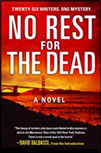 NO REST FOR THE DEAD
NO REST FOR THE DEAD
J.A. Jance is among more than twenty New York Times bestselling authors who have teamed up to create a first-rate serial novel—a collaboration that combines the skills of America’s greatest storytellers to produce a gripping, spellbinding mystery.
A brother-and-sister editing team, Andrew and Lamia Gulli have arranged to donate all proceeds from No Rest for the Dead (excluding contributor expenses) to the Leukemia & Lymphoma Society.
 CHICKEN SOUP FOR THE SOUL, INSPIRATION FOR WRITERS
CHICKEN SOUP FOR THE SOUL, INSPIRATION FOR WRITERS
No matter the genre, no matter the medium, the writing process is hard! But you will find inspiration, encouragement, and advice in these 101 stories from others who have stuck with it, through the setbacks and struggles, and successfully went from dreaming about writing to being a writer.
J.P. BEAUMONT
JOANNA BRADY
ALI REYNOLDS
WALKER FAMILY
POETRY
SHORT STORIES
AUTOGRAPHED COPIES
BOOK LIST
PUBLISHER J.A. Jance PAGES
SHORT STORIES & INDIE BOOKSTORES
